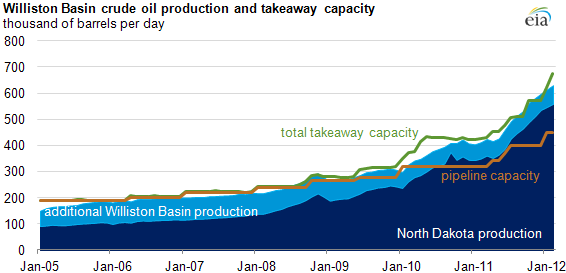
Williston Basin crude oil production and takeaway capacity are increasing

Notes: Takeaway capacity is the total capacity for moving crude oil out of the Williston Basin, via pipeline, rail, and truck. Crude oil production values are based on estimates.
Crude oil production from the Williston Basin (primarily the Bakken formation) recently increased to more than 600 thousand barrels per day (bbl/d), according to Bentek Energy, LLC (Bentek), testing the ability of the transportation system—oil pipelines, truck deliveries, and rail—to move crude oil out of the area (see chart above). The current price gap between Bakken crude oil and West Texas Intermediate (WTI) shows the effects of this constraint. Bentek projects more transportation capacity coming online in 2012, potentially alleviating this constraint.
Due to pipeline capacity constraints, Williston Basin producers rely on rail and trucks to move additional crude oil out of the region. Because of these transportation constraints, Bakken crude oil currently sells at a discount of $7.50 per barrel to WTI. This discount was as much as $28 per barrel in February 2012 and is expected to continue as long as transportation constraints persist.
Currently, North Dakota has only one refinery, which processes about 58 thousand bbl/d of crude oil. Crude oil is delivered to other markets using a combination of pipeline, rail, and truck. Delivery capability as of April 2012 was: 450 thousand bbl/d by oil pipeline; 150 thousand bbl/d by rail; and small volumes by truck. However, in 2012, incremental additions to rail and oil pipeline capacity for the Williston Basin could total 350 thousand bbl/d.